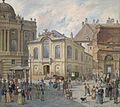The Creation (Haydn) facts for kids
The Creation is a very famous piece of music by Joseph Haydn. It's called an oratorio, which is like a big concert performance that tells a story using singers and an orchestra. This particular oratorio celebrates how the world was made, just like it's described in the Book of Genesis from the Bible. Many people think it's one of Haydn's best works!
Contents
What is an Oratorio?
An oratorio is a large musical piece for an orchestra, a choir, and solo singers. It's usually based on a religious story. Think of it like a play, but without costumes, sets, or acting. The music and the singing tell the whole story. The Creation is one of the most well-known oratorios ever written.
Who Was Joseph Haydn?
Joseph Haydn was an amazing composer from Austria. He lived from 1732 to 1809. He's often called the "Father of the Symphony" and the "Father of the String Quartet" because he helped shape these types of music. Haydn wrote over 100 symphonies, many string quartets, and several oratorios, including The Creation. He was a very important musician during the Classical period of music.
The Story of Creation in Music
The Creation tells the story of the first six days of creation, as found in the Bible. Haydn's music brings this story to life in a wonderful way.
Day One: Light and Darkness
The music starts with a powerful part called "The Representation of Chaos," which sounds like the world before anything was formed. Then, when God says "Let there be light," the music suddenly becomes bright and grand. It's a really exciting moment!
Days Two and Three: Sky, Water, and Land
Haydn's music then describes the creation of the sky, the separation of the waters from the land, and the appearance of mountains, rivers, and plants. You can almost hear the water flowing and the plants growing through the orchestra's sounds.
Days Four and Five: Sun, Moon, Stars, and Animals
On the fourth day, the sun, moon, and stars are created. The music for this part is very majestic. Then, the fifth day brings fish to the seas and birds to the sky. Haydn uses different instruments to imitate the sounds of various animals, like the eagle soaring or the nightingale singing.
Day Six: Land Animals and Humans
Finally, on the sixth day, land animals are created, from the mighty lion to the gentle sheep. The music cleverly shows their different movements and sounds. The oratorio ends with the creation of humans, Adam and Eve, and a beautiful chorus praising God's work.
Why is The Creation So Special?
The Creation is loved for many reasons. Haydn's music is full of beautiful melodies and exciting parts. He uses the orchestra and singers to paint vivid pictures in your mind, making you feel like you're right there experiencing the creation of the world. It's a joyful and inspiring piece that celebrates the beauty of nature and life.
Images for kids
-
Portrait of the librettist Gottfried van Swieten, Austrian politician and librarian
-
A view of plant life that Haydn knew well. Albert Christoph Dies created this painting of the beautiful palace gardens in Eisenstadt, the property of their shared employer Prince Esterházy. Dies also penned a Haydn biography.
-
God creates the sun and moon: detail from Michelangelo's Sistine chapel ceiling
-
The nightingale (Luscinia megarhynchos) has served as a powerful literary symbol for millennia; for discussion see Nightingale
-
Detail from The Creation of Adam by Michelangelo, c.1512
See also
 In Spanish: La creación (Haydn) para niños
In Spanish: La creación (Haydn) para niños










